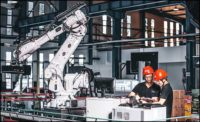Modernization is a necessary part of business, particularly in industrial environments. It does several things, not the least of which is improving efficiency and productivity for the equipment in question. It also reduces the need to replace other components connected to the machinery, lowers operating costs, and keeps the entire operation flowing by mitigating setbacks and delays. That includes improving or modernizing process and heating systems, such as an industrial process heater.
Process heating is fundamental but requires lots of energy and resources. The usefulness of the system is generally determined by how much heat it can produce, and more heat leads to more energy consumption. Traditionally, swapping to more efficient systems sacrifices heat — and product quality — to deliver the same results with less input or less energy. That’s been true for many years, until recently. Modern technology is capable of producing a process heater that’s efficient and effective yet doesn’t reduce product quality and system capabilities.
Because there are so many different types of process and heating systems, there are many ways to go about modernizing these solutions.
Enhancing Process Heating Solutions
There are three major types of process heating systems: electricity-based, fuel-based, and steam-based. They all require resources or consume energy to run, but it’s how they utilize these resources that matter most for efficiency and sustainability.
Modernizing and improving their efficiency is all about redesigning the system to reduce waste and use fewer resources, but provide the same levels of output and quality.
Install IoT or Connected Sensors
Bringing devices online, even legacy equipment, is an excellent way to build a better understanding of how systems and processes are working, how efficient they are, and where they can be improved. Industrial IoT applications span many industries, including process heating and manufacturing solutions.
It’s possible to replace equipment with new connected technologies, but there are also ways to bring old systems to the modern age with digital data tracking. Connecting IoT sensors and applications, for example, can reveal new insights about a particular piece of equipment or segment of the operation. Sometimes, it’s as easy as installing an IoT-ready device, but you will need to consider whether your current equipment is compatible or not. It’s always best to consult with an industrial internet of things (IIoT) professional.
Working directly with industrial process heater manufacturers can net you a custom-built system, designed specifically for what you’re doing and what kind of components you’re creating. For example, users can choose pump configuration, horsepower, and even adjust the size of a boiler, but to do so, you’ll need to work with those that offer custom selections and configurations.
Minimize Heat and Volume of Exhaust Gases
Industrial process heaters release exhaust gases, and understanding the conditions of these gases can help improve the entire system.
For example, excess heat that’s apparent in the exhaust can be a sign of inferior heat transfer. It’s possible to lower the temperature of exhaust gases by maximizing heat transfer to the materials and deploy heat recovery devices to recycle the heat. Adjusting pump selection and the distance gases travel within the system can provide an efficiency boost as well.
You might also consider reducing the number of openings to better control furnace pressure. This prevents air leaks and minimizes excess air buildup in burners. You could even enrich combustion air by injecting oxygen, which reduces the volume of exhaust gases and significantly improves system efficiency.
Upgrade Handling and Periphery Equipment
When working with process heating systems, there are many accessories, additional equipment options, and peripheral components that play a role. It’s because there’s so much heat involved, and workers, supporting systems, and other applications cannot be exposed or come into contact with such extreme levels. But things like the handling equipment can directly affect the efficiency of the system, especially when they’re massive. Trays and baskets, for example, and their added weight can slow down the heating process.
Additionally, when components are moving along a conveyor belt, the longer the distance, the more time they have to cool and influence the heating process.
Keeping all equipment within the appropriate proximity is a major consideration, as is choosing the appropriately sized supporting and materials handling equipment. It may even be possible to swap them for lighter, yet equally durable, materials.
Review Industrial Process Heater Insulation
Like doors or windows in a home, the level and quality of insulation in a process heater can affect the temperatures within. Choosing insulation with the proper thickness and sealing properties will ensure there is no heat loss, and a more even temperature is maintained. What’s more, keeping the doors, hinges, or latches to a system closed is imperative, especially before operation or between uses. Even when the system is not running and shut down, keeping the doors closed and properly sealed can retain a lot of heat that rolls back into future applications.
Review the insulation with maintenance teams regularly to ensure it’s in proper condition and that there’s no decay or degradation. Whenever applicable, measure temperatures inside the process heater to ensure they are properly balanced and well-maintained.
Conduct Consistent System Inspections
Another aspect of process heaters that should be reviewed regularly is the system itself, including specifications and performance statistics — like energy consumption. It’s possible to assess these elements and see where a system is lacking or falling behind. A system that’s using way too much energy, for example, can be upgraded, renewed, or replaced entirely when there are no other options. But the only way to know for sure what should be done is to continue analyzing and assessing the equipment.
First, establish a baseline for what the industrial process heater or industrial chiller should achieve with clear temperature limits. When the system crosses the lower thresholds, you know it’s time to renew or upgrade. You can also use maintenance checks to understand how a system is degrading over time, and if there are ways to fix the problems.
Understand and Follow Rated Capacities
Industrial process heating solutions have a rated operating capacity for a reason. It’s where they operate best, with the highest level of efficiency and performance. Understanding these capacities or limitations is vital to keeping the operation as optimal as possible.
Make sure you and your crew understand what the rated capacities are, and that the systems remain at those levels. This is also a great candidate for IoT reporting and real-time data solutions. With the right sensors, you can better maintain those rated capacities with faster reaction times when levels fall out of the norm.
Welcome to the New Age of Industrial Process Heating
Traditional process heating and similar applications require an inordinate amount of energy and resources, but it doesn’t have to stay that way. Through efficiency upgrades, whether replacing equipment entirely, or improving upon its original design, it’s entirely possible to see higher output, better performance, less waste, and other benefits.
Emerging electrotechnologies in the sector have demonstrated it’s possible to reduce energy consumption and on-site emissions. Deploying IoT and bringing legacy devices online, for instance, can introduce a host of new real-time data insights that can be leveraged to improve the operation. Imagine monitoring heat in real-time to make adjustments so the system runs better and maintains the proper conditions. Products come out the other end with higher quality and to the exact specifications of the project.
If you haven’t already, you might consider revising, renewing, or upgrading your existing industrial process heater equipment.





